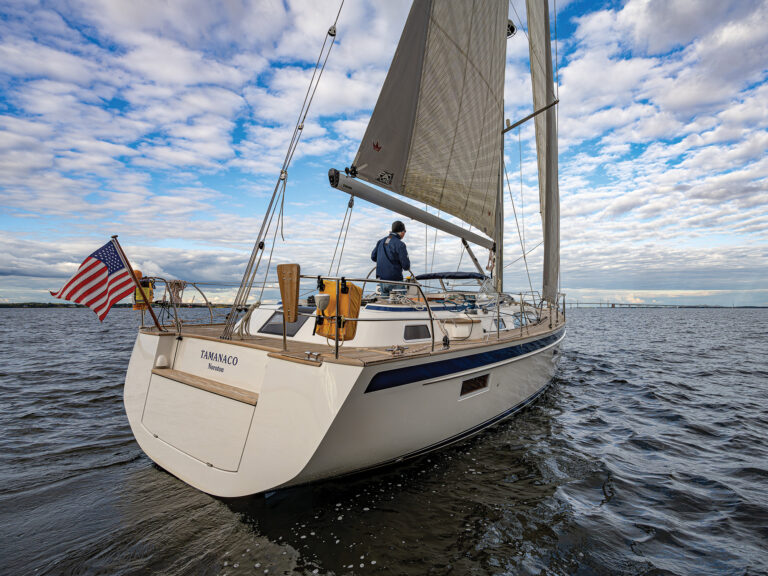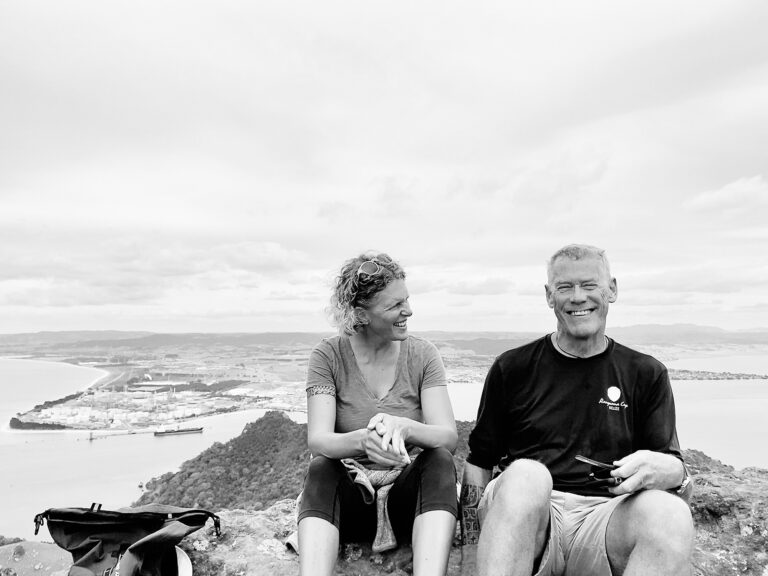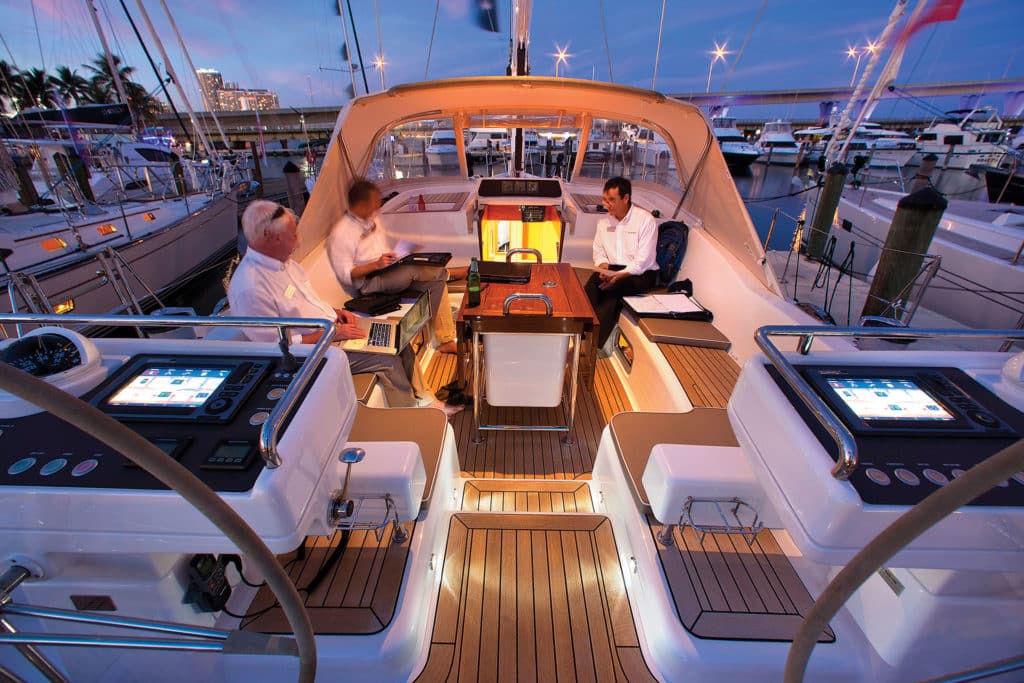
Oyster 625 Cockpit
The Merriam-Webster online dictionary defines a cockpit as “A space or compartment in a usually small vehicle (as a boat, airplane, or automobile) from which it is steered, piloted, or driven.” Quite right, but it also offers another equally apt definition: “A place noted for especially bloody, violent, or long-continued conflict.”
I say apt because poor cockpit design can result in repetitive bloodshed and a violent motion under way, and can make even the shortest of tempests feel like a conflict of extended duration.
The form, function and fashion of cockpits have changed radically in but a few nautical generations. A single compass aside, the traditional cockpit was not the navigation station. It housed only the tiller, and the main and jib sheets, requiring the sailor to — imagine this — go forward to hoist, hand and reef sails. It certainly was not self-draining nor protected from the sun and spray, nor was it replete with courtesy lighting, lush cushions, drink coolers and musical accompaniment. Lest I sound nostalgic for the good old days when sailors were manly men (because sensible women would not sail with them), let me applaud the clear improvements made in modern cockpit design.
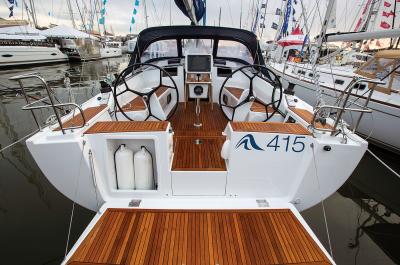
| |The drop-down transom on the Hanse 415 is well-executed. Along with the handy swim platform aft, the cockpit features a central table with a chartplotter mounted amidships for good visibility from the twin helms. A nice touch is the dedicated locker for stashing fenders.|
Still, each cockpit must be designed to match the characteristics of the hull to which it is attached. For example, if a vessel carries substantial beam well aft to the transom (as most modern yachts do), and the designer has decided to raise the cockpit sole and forgo wide side decks to achieve more interior volume, the result will be a very high and wide cockpit. But if that same vessel has a light ballast ratio, a shoal keel and a sail plan with a high center of effort, it will not stand firm to its canvas. Even in a moderate breeze the view from the cockpit’s windward perch will be reminiscent of that first nervous peek over the edge of a high-dive, and pity the soul who suffers a long fall into forge-hardened winches or cheese-cutter lifelines to leeward.
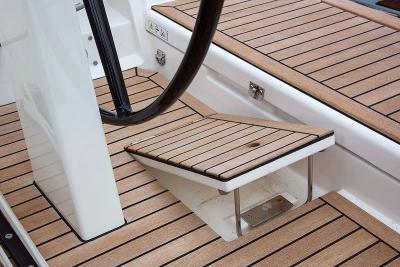
| |_The Xp-38 is a well-found racer-cruiser from Denmark with lots of interesting touches, including this raised “convertible” platform directly aft of the wheel to provide level footing for the helmsman when the boat is heeling. _|
Thus sensible design does not confuse expansiveness with spaciousness. A spacious cockpit will have plenty of room to lounge and entertain, but will ensure that the crew is safely contained within, protected from sea spray and sun, yet still have room enough to perform sailing functions efficiently.
Except in the largest of production boats (Passport, Oyster, Hylas and the top end of the Hallberg-Rassy range), center cockpits are fading from the new-boat fleet. By increasing both beam and freeboard aft, designers can specify a spacious aft cabin (or two) without having to incorporate a raised trunk cabin. Putting aside all other arguments, pro and con, the primary reason for center-cockpit designs has become moot now that the cockpit can be placed directly above an aft cabin without compromising standing headroom.
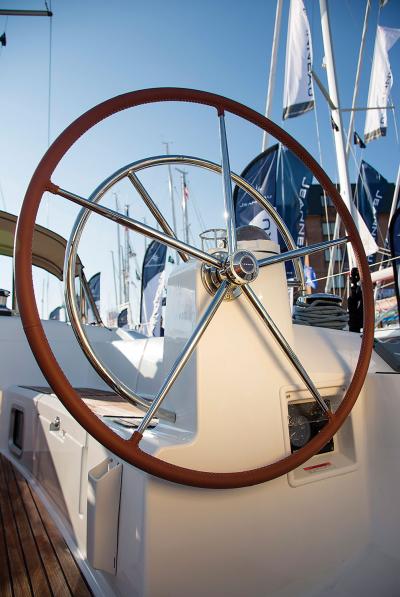
| |_Aboard the Jeanneau 509, the molded pedestal for the steering wheel also provides a nice, rounded seat back just forward, adjacent to the long cockpit bench. _|
Increased freeboard, however, has made boarding modern vessels more difficult (although the trend toward aft-entry cockpits has alleviated this problem when stepping aboard from a dinghy). For years clever sailors and builders experimented with add-on sugar scoops at the transom. These extensions increased the waterline and therefore the theoretical hull speed; created a cleaner wake; and, lo and behold, were a lovely spot to swim from, clean fish and so on. But one still had to climb over the taffrail to access the platform.
Cutting an aft companionway through the transom, and configuring the aft pulpit accordingly, has permitted ease of access to and fro. Nearly all major manufacturers now offer aft-entry cockpits with further enhancements such as drop-down swim ladders, shower nozzles, life raft stowage lockers, etc. The only discernable disadvantage is that these platforms mostly preclude mechanical self-steering systems. While the ever-increasing height of the cockpit sole may exaggerate the motion at sea, combined with an open transom this allows for rapid drainage and eliminates the need for multiple scuppers, hoses, clamps and through-hull fittings.
The latest cockpit craze is the drop-down hinged transom. When raised, it provides gunwale-to-gunwale aft seating and creates the sense of security that only comes from an entirely enclosed cockpit; when lowered, it becomes the aforementioned boarding platform. Either a simple rope/tackle setup or an electric or hydraulic mechanism operates these platforms. Although these “trick transoms” may at first seem gimmicky, in tight marinas their ability to retract can be very handy, particularly by extending usable deck space (when down) while reducing the cost of berthing (when up). Flip-up transoms — such as those found on the Beneteau Sense 46, where the helm seats fold up to open the entire transom — are an offshoot of this idea, though they don’t provide the same containment aft.
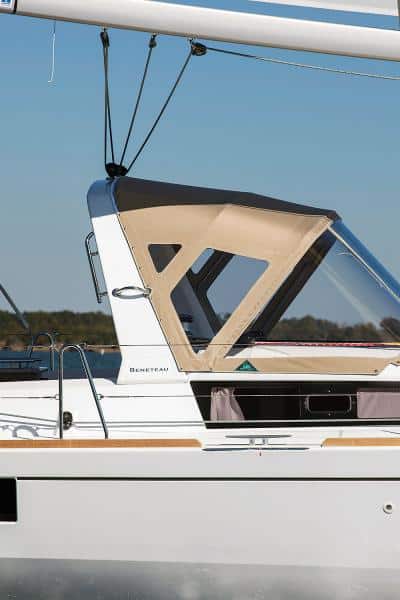
| |_The integral arch over the cockpit of the Beneteau Oceanis 48 serves multiple purposes: It provides good handholds and an excellent frame for a strong dodger, and also anchors the mainsheet _fittings.|
On a related subject, the penchant for enormous-diameter “racing” wheels almost universally obstructed the flow from the helm forward. In a tacit admission of this problem, many major manufacturers began offering removable and, more recently, folding wheels. While this addressed the problem dockside or at anchor, when under way the helmsperson still literally had to climb over the racing wheel to release the main, which was less than ideal.The latest cockpit craze is the drop-down hinged transom. When raised, it provides gunwale-to-gunwale aft seating and creates the sense of security that only comes from an entirely enclosed cockpit; when lowered, it becomes the aforementioned boarding platform. Either a simple rope/tackle setup or an electric or hydraulic mechanism operates these platforms. Although these “trick transoms” may at first seem gimmicky, in tight marinas their ability to retract can be very handy, particularly by extending usable deck space (when down) while reducing the cost of berthing (when up). Flip-up transoms — such as those found on the Beneteau Sense 46, where the helm seats fold up to open the entire transom — are an offshoot of this idea, though they don’t provide the same containment aft.
Enter today’s most significant cockpit design concept: twin helms. Placing the wheels as far outboard as possible provides numerous advantages, the most obvious being the safety gained through redundancy. Next, with two wheels the driver can choose which helm affords the best view of the sail trim or the approach to a dock, or provides more protection from the elements. The respective helm binnacles help separate the work stations from the lounging areas yet do not interfere with the helms-person’s access to the winches and cabin-top hardware. The only disadvantage may be found in smaller craft, where shortened cockpit benches may not be long enough to sleep on.
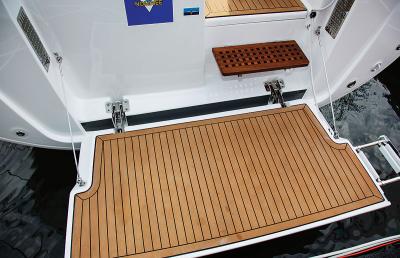
| |Just forward of the folding transom on the Bavaria Vision 46, a nice grate provides drainage for the outdoor shower. Note the swim ladder, offset to starboard.|
The center aisle created by this layout is spacious enough to incorporate a console-style cockpit table with all the attendant amenities, including chart plotters, footrests, handholds, drink holders, mini-coolers and night lighting, as well as an expanding party-central table. If well designed and smartly situated, these fixed console tables don’t obstruct movement either athwartships or to the companionway, and they also compartmentalize the space so there’s little room to take a hard fall.
How the companionway is covered — with a doghouse, or a hard or soft dodger — is relevant. Protection from the wind, rain, sun and sea is important, and the modern solution of draping the cockpit in canvas certainly provides that. But that protection cannot come at the expense of visibility forward or up to the masthead. As the halyards are now almost universally led to the cabin top and tended to via a bank of rope clutches, the combination of a powerful winch (often electric) and an obstructed view of the mainsail due to an overly extended dodger almost always guarantees a trip to the sailmaker for repairs.
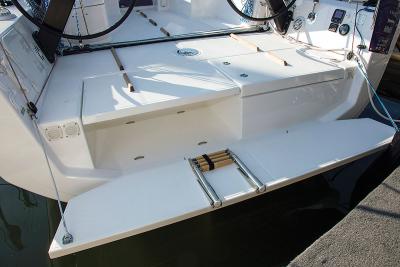
| |_The nearly open transom on the racy Dufour 36 still has room for a shallow but workable swim platform, but the coolest part of this arrangement is the enclosed space to stash a life raft. _|
The colossal biminis found on many new craft are too often not incorporated into the original design; these look odd, and with poorly placed tensioning straps, they obstruct entry into and out of the cockpit while flapping and humming in the wind. Even worse, they obstruct the view of the sails, jib telltales and masthead Windex from the helm. A helmsperson must always have a keen sense of trim and the ability to see where the dangerous jibe point exists. It is essential that large, clear ports are cut into the bimini in the precise locations to provide these vantage points. As a personal aside, I sail specifically to connect to the forces of nature, not to feel insulated “indoors.”
A more favorable trend is the removal of the mainsheet track from the cockpit in all but the most competitive racer/cruisers. In smaller vessels, this track has often been moved forward of the dodger. On many larger vessels, the mainsheet is led forward from the aft end of the boom, down to a set of blocks at deck level, and then under the deck to re-emerge in the cockpit. Hunter places its mainsail tracks on an arch above the cockpit. All these options clear the clutter of block and tackle from the cockpit, and reduce the chance of injury due to accidental jibes.
Another good idea is the radar arch that neatly houses all the modern necessities such as GPS and satphone antennae, solar panels, wind generators, outboard engine hoists and fishing reels. On larger craft it also serves as a set of stout davits. Some of the new, stylish arches, such as those found on the Beneteau Sense 55, are quite handsome and look nothing like the older, first-generation stainless pipe arrangements.
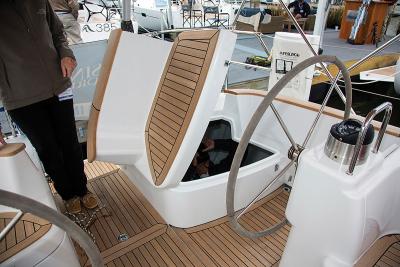
| |On the Moody 41, the helmsman’s seat serves double duty as a cockpit locker. |
Because the sheets, halyards, vang, reefing lines and traveler controls are now all led aft, dedicated sheet wells help tame the ensuing tangle. Other small trends of note are concave footwells at the helms, removable footrests and, due to the open nature of today’s cockpits, the absence of grating underfoot.
In summary, the cockpit has evolved into the most active area of the vessel. With all running rigging run aft, most sailing functions occur here. With windlass controls duplicated at the binnacle, dropping and weighing anchor occur here. With waterproof touch screens, twin compass binnacles and a VHF station, nearly all the navigation and communication occur here. With the generous aft platforms, outdoor recreation such as swimming, diving and fishing occur here. With enormous tables, ergonomically sculpted seating and backrests, sophisticated outdoor sound systems, night lights and coolers, most social activity occurs here.
The contemporary cockpit has become control central. When assessing this space aboard any vessel, it has become increasingly necessary to look for the fine balances between spaciousness and safety, and style and function.






